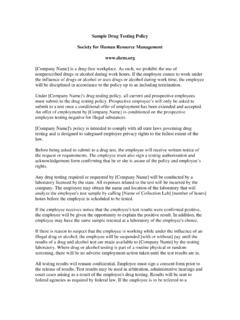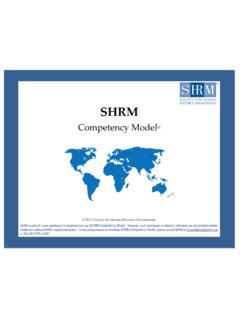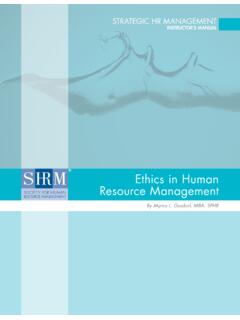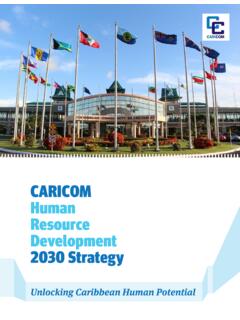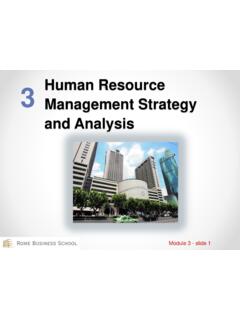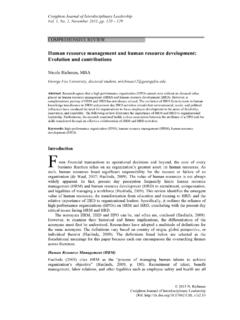Transcription of Chapter 8. Human Resource Development - OECD
1 OECD 2012. A publication of the Investment Division of the OECD Directorate for Financial and Enterprise Affairs. OECD freely authorises the use of this material for non-commercial purposes. All requests for commercial use or translation of this material should be submitted to This work is published on the responsibility of the Secretary-General of the OECD. The opinions expressed and arguments employed herein do not necessarily reflect the official views of the Organisation or of the governments of its member countries. This document and any map included herein are without prejudice to the status of or sovereignty over any territory, to the delimitation of international frontiers and boundaries and to the name of any territory, city or area.
2 POLICY FRAMEWORK FOR INVESTMENT USER S TOOLKIT Chapter 8. Human Resource Development Introductory note The PFI User s Toolkit responds to a need for specific and practical implementation guidance revealed from the experience of the countries that have already used or plan to use the PFI. Development of the Toolkit has involved government users, co-operation with other organisations, OECD Committees with specialised expertise in the policy areas covered by the PFI and interested stakeholders. Against this background, this document offers guidance relating to the Human Resource Development Chapter of the PFI. The PFI User s Toolkit is purposely structured in a way that is amenable to producing a web-based publication.
3 A web-based format allows: a flexible approach to providing updates and additions; PFI users to download the guidance only relevant to the specific PFI application being implemented; and a portal offering users more detailed resources and guidance on each PFI question. The website is accessible at 2 Human Resource Development Human Resource Development (HRD) policies concern the quality of the labour force and the regulation of the labour market. Quality in turn is a function of basic and higher education, training programmes and the overall health of the population. The quality and adaptability of the labour force is a key driver in creating a favourable environment for both domestic and foreign enterprises to grow through new investment and to adapt quickly to changing circumstances.
4 Their relative roles and the overall importance of HRD depend on individual country circumstances, particularly the economic structure. Even more important than these individual HRD policies is the interaction among them. Attempts to boost workforce skills through vocational training without considering their interaction with basic educational attainment or flanking labour market policies are likely to be ineffective. Human Resource Development requires a comprehensive strategy that takes full account of the linkages between, for example, improved population health on educational attainment and, depending on employment policies, on labour productivity. This Chapter deals with how Human Resource Development policies can contribute to an environment that is attractive to domestic and foreign investors and can enhance the benefits of investment to society .
5 A premise of the Chapter is the linkage between government and private investments in education, training and population health with physical investment: increased investment in Human Resource Development attracts higher capital spending by enterprises, provided the general business environment is appropriate. The Chapter examines and distils the lessons from how government HRD policies, including labour market policy, bear on business investment decisions and the key features that determine their success from a wider Development perspective. The 10 PFI questions on Human Resource Development relate to: HRD policy framework Basic schooling Higher education Training programmes Health Labour market laws and regulations: Core labour standards Balancing multiple objectives of labour market regulations The role of foreign workers Labour market adjustment Labour market regulations and workforce adaptability 3 HRD policy framework Has the government established a coherent and comprehensive Human Resource Development (HRD) policy framework consistent with its broader Development and investment strategy and its implementation capacity?
6 Is the HRD policy framework periodically reviewed to ensure that it is responsive to new economic developments and engages the main stakeholders? Rationale for the question Human Resource Development has multiple dimensions, covering educational attainment, workforce skills, population health and the set of employment policies that provide businesses with workers with appropriate skills and the ability to adapt quickly to new challenges. Each of these areas is a key driver in creating a favourable environment for investment. Because HRD policies are all closely inter-related and must be consistent with a country s broader Development and investment policies, they cannot be framed in isolation.
7 Low Human Resource Development needs to be tackled through a coherent and comprehensive strategy that takes full account of the policy linkages and a country s implementation capacity. The policy framework needs to be flexible in order to respond to the new skill needs created by changing technologies and economic structures. The falling cost and rising quality of information and communication technologies, for example, is raising the demand for skilled workers, making low Human Resource Development an increasing obstacle to inward investment. At the same time, these forces also offer an opportunity for emerging economies to integrate more quickly into the global economy, as businesses restructure their supply chain and operations to gain from regional comparative advantages.
8 HRD policies must therefore be adaptable and constantly fine-tuned in order quickly to respond to the changing skill needs created by new challenges and to ensure the contribution of investment for Development . For this to happen, close co-operation between policy makers and the main stakeholders and periodic assessments of the impact of HRD policies on the business and investment environments are needed. 4 Basic schooling What steps has the government taken to increase participation in basic schooling and to improve the quality of instruction so as to leverage Human Resource assets to attract and to seize investment opportunities? Rationale for the question Access to basic education for girls and boys is a Human right and educational attainment at the primary and lower secondary levels is a minimum necessary condition for Development .
9 Broad access to basic education also underpins a healthy investment environment. Formal educational attainment also provides the foundations for further learning and safeguards the capacity to seize future investment opportunities. Despite positive trends in school enrolment, many countries under invest in Human capital, due in part to a range of market failures and poverty. In these circumstances, without policy intervention, investment in early childhood, primary and lower secondary education will be suboptimal, feeding under-skilled workers into the labour market, disconnected with the requirements of business. Investment in Human capital over two decades in 17 emerging economies has accounted for about of a percentage point in their annual growth, and among OECD countries, one more year of schooling can increase GDP per capita by 4%-7% OECD/UNESCO (2003), Financing Education: Investment and Returns, Paris.
10 Human capital is one of the most important determinants of the investment location decision of foreign firms and its importance has grown over time, according to a study of 36 developing countries. Noorbakhsh, Farhad et al. (2001), Human Capital and FDI Inflows to Developing Countries: New Empirical Evidence, World Development 29(9). In Latin America and the Caribbean, a 1% decline in the illiteracy rate can increase FDI by Daude, C. et al. (2003), Core labour standards and foreign direct investment in Latin America and the Caribbean: does lax enforcement of labour standards attract investors? IADB mimeo, Washington. Roughly one in five firms in many developing countries rate inadequate skills and education of workers as a major or severe obstacle to their operations.










